Old English Grammar. Morphology. Lecture 1. 3










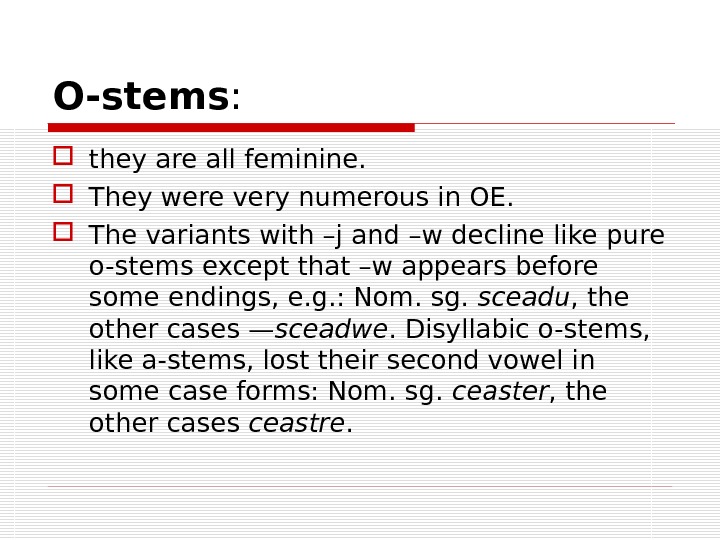








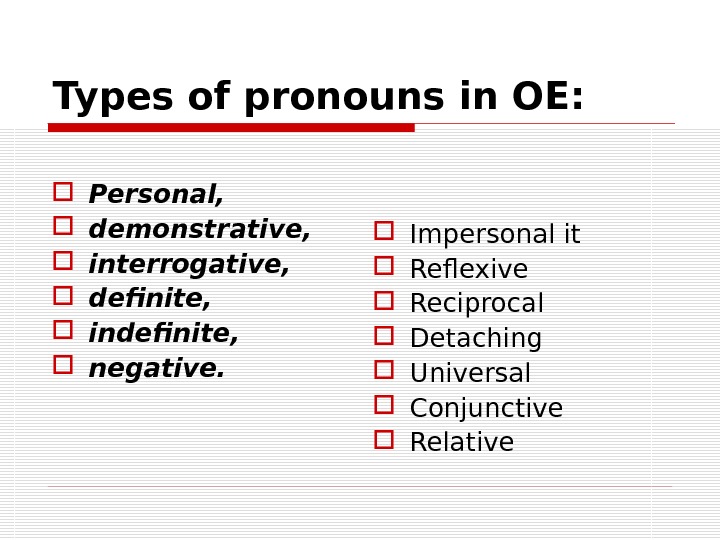
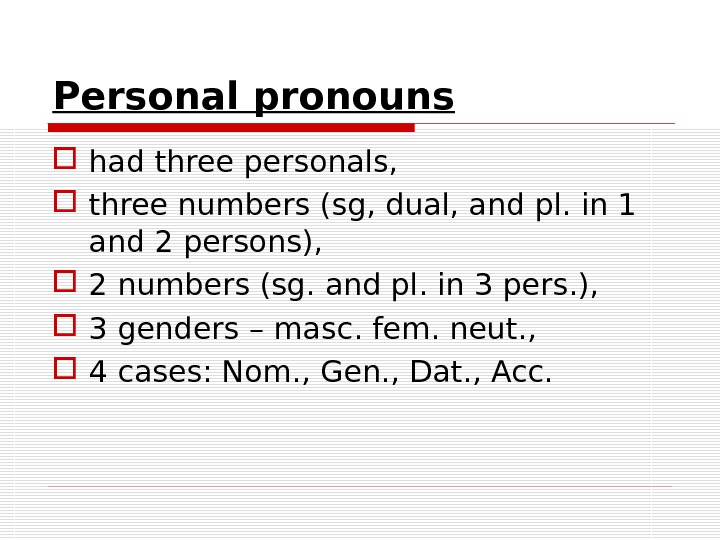








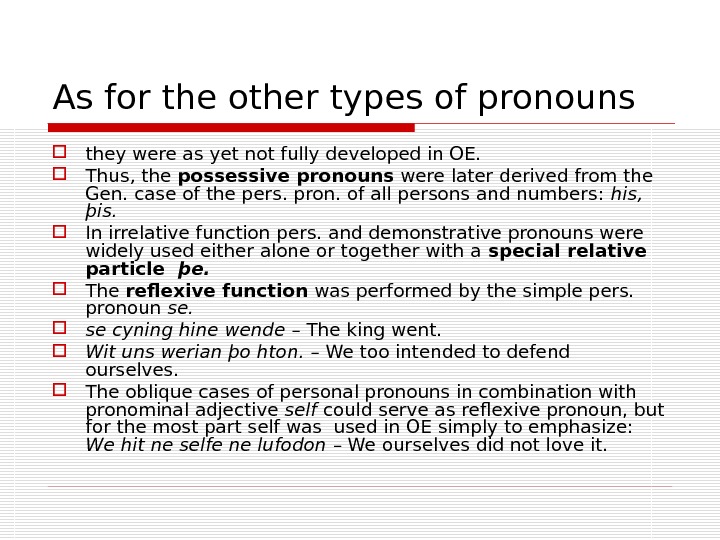



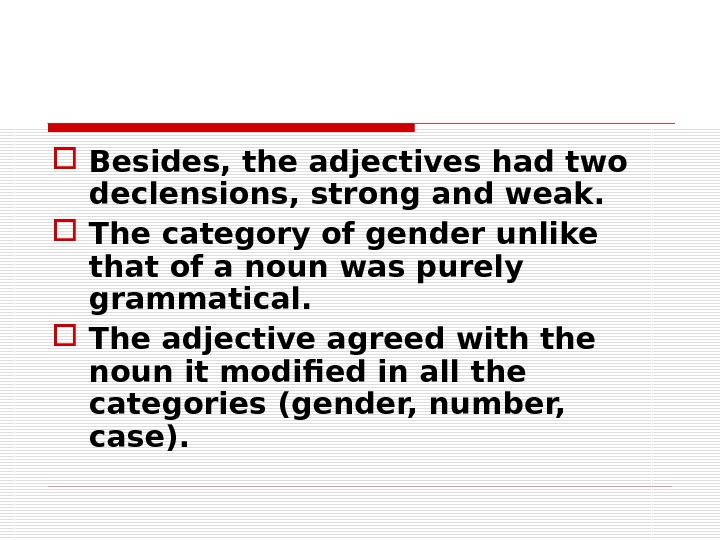

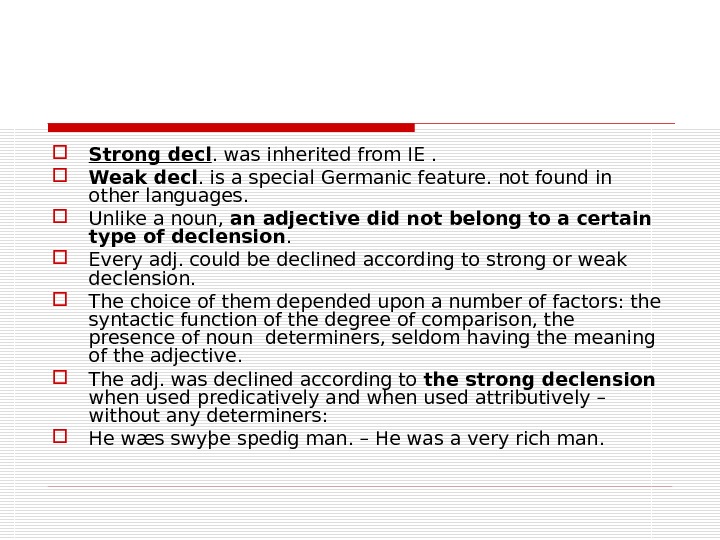







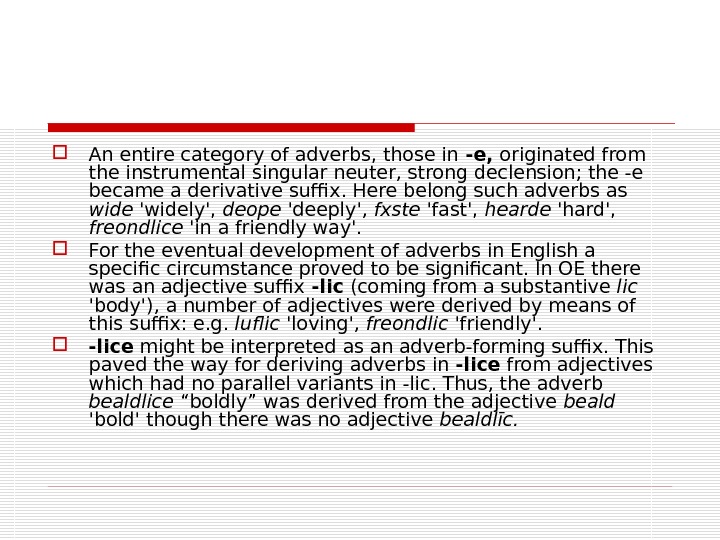
















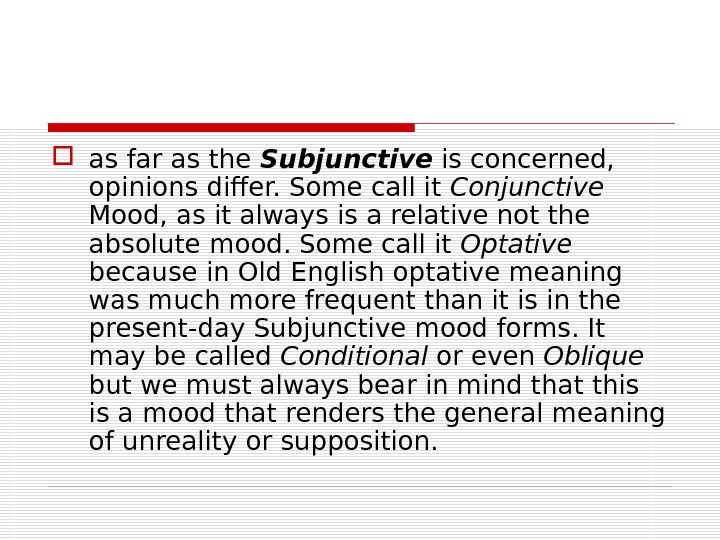
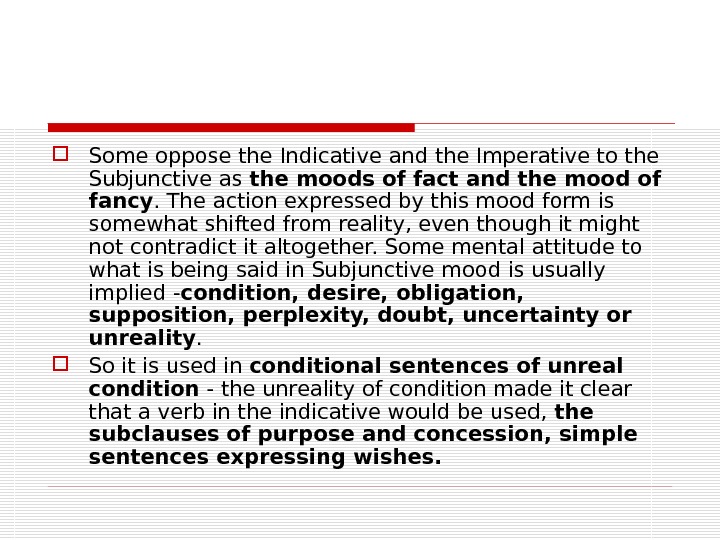















- Размер: 435 Кб
- Количество слайдов: 77
Описание презентации Old English Grammar. Morphology. Lecture 1. 3 по слайдам
 Old English Grammar. Morphology. Lecture 1.
Old English Grammar. Morphology. Lecture 1.
 1. Old English Grammar. 1. Noun. 2. Pronoun. 3. Adjective. 4. Adverb. 5. Numeral. 6. Verb
1. Old English Grammar. 1. Noun. 2. Pronoun. 3. Adjective. 4. Adverb. 5. Numeral. 6. Verb
 OLD ENGLISH NOUN
OLD ENGLISH NOUN
 LEXICO-GRAMMATICAL CATEGORIES The Old English noun had following grammatical categories – gender, number, case.
LEXICO-GRAMMATICAL CATEGORIES The Old English noun had following grammatical categories – gender, number, case.
 Gender was a lexico-grammatical category. Every noun with all its forms belonged to one gender. In OE there existed several nouns, referring to different genders. — ere : fisca – fiscere “ fisherman” — estre : family nouns: spinestre – “ пряха ” — þa / þu : for abstract nouns: gender was treated according to semantics of a noun – mann, cwene. But some nouns were with unjustified gender forms: wif (n) “wife” wifman “ woman” (f) mægden (n)
Gender was a lexico-grammatical category. Every noun with all its forms belonged to one gender. In OE there existed several nouns, referring to different genders. — ere : fisca – fiscere “ fisherman” — estre : family nouns: spinestre – “ пряха ” — þa / þu : for abstract nouns: gender was treated according to semantics of a noun – mann, cwene. But some nouns were with unjustified gender forms: wif (n) “wife” wifman “ woman” (f) mægden (n)
 The category of case was represented by 4 cases: Nominative, Genitive, Dative, Accusative. Case
The category of case was represented by 4 cases: Nominative, Genitive, Dative, Accusative. Case
 Morphological classification Nouns were divided into several types of declensions of stems. There were strong and weak declensions. They were distinguished according to the type of their stems.
Morphological classification Nouns were divided into several types of declensions of stems. There were strong and weak declensions. They were distinguished according to the type of their stems.
 2. 1 Strong Declension : a-stems (with their variants ja-stems and wa-stems) o-stems (with their variants jo-stems and wo-stems) i-stems u-stems
2. 1 Strong Declension : a-stems (with their variants ja-stems and wa-stems) o-stems (with their variants jo-stems and wo-stems) i-stems u-stems
 A-stems included masc. and neut. nouns. 1/3 of OE nouns were Masc. a-stems. The difference between the two genders is only seen in the nominative and accusative plural, where masculine nouns had the ending –as, whereas the ending of neut. noun depends on the number of syllable contained a short vowel + a consonant. scĭp ( корабль ), deor ( олень ) A long syllable contains a long vowel + a consonant, or a short vowel + 2 consonants. In monosyllabic words with a short root syllable the neuter nouns in the nominative and accusative plural had the ending –u. Scipu → ships In monosyllabic neuter words with a long root syllable in these cases had zero ending. In disyllabic nouns with a long vowel if had -u- ending. The modern irregular plural forms sheep, swine, gees are traced to the neuter nouns of a-stem declension (they were used more often). There were two variants of a-stem : ja-stems: nom. case, sg. , masc. – ende; pl. -endas wa-stems: nom. case, sg. , masc. – cneo(w); pl. – cneo(w)
A-stems included masc. and neut. nouns. 1/3 of OE nouns were Masc. a-stems. The difference between the two genders is only seen in the nominative and accusative plural, where masculine nouns had the ending –as, whereas the ending of neut. noun depends on the number of syllable contained a short vowel + a consonant. scĭp ( корабль ), deor ( олень ) A long syllable contains a long vowel + a consonant, or a short vowel + 2 consonants. In monosyllabic words with a short root syllable the neuter nouns in the nominative and accusative plural had the ending –u. Scipu → ships In monosyllabic neuter words with a long root syllable in these cases had zero ending. In disyllabic nouns with a long vowel if had -u- ending. The modern irregular plural forms sheep, swine, gees are traced to the neuter nouns of a-stem declension (they were used more often). There were two variants of a-stem : ja-stems: nom. case, sg. , masc. – ende; pl. -endas wa-stems: nom. case, sg. , masc. – cneo(w); pl. – cneo(w)

 O-stems : they are all feminine. They were very numerous in OE. The variants with –j and –w decline like pure o-stems except that –w appears before some endings, e. g. : Nom. sg. sceadu , the other cases — sceadwe. Disyllabic o-stems, like a-stems, lost their second vowel in some case forms: Nom. sg. ceaster , the other cases ceastre.
O-stems : they are all feminine. They were very numerous in OE. The variants with –j and –w decline like pure o-stems except that –w appears before some endings, e. g. : Nom. sg. sceadu , the other cases — sceadwe. Disyllabic o-stems, like a-stems, lost their second vowel in some case forms: Nom. sg. ceaster , the other cases ceastre.

 I-stems and U-stems include nouns of different genders. Masc. and Fem. u-stems decline like Fem. duru (NE door ). The masculine and neuter I-stems didn’t much differ in their declension from the a-stems, because root vowel had undergone mutation. Neuter. i-stems are declined like Neut. ja-stems. Among Masc. i-stems only names of peoples regularly formed their pl. in the old way: Dene, Engle. Fem. i-stems resembled o-stems.
I-stems and U-stems include nouns of different genders. Masc. and Fem. u-stems decline like Fem. duru (NE door ). The masculine and neuter I-stems didn’t much differ in their declension from the a-stems, because root vowel had undergone mutation. Neuter. i-stems are declined like Neut. ja-stems. Among Masc. i-stems only names of peoples regularly formed their pl. in the old way: Dene, Engle. Fem. i-stems resembled o-stems.
 2. 2 Weak Declension N-stems : they were very numerous. They included many Fem. (cirice, eorÞe, heorte — church, earth, heart) and Masc. nouns (cnotta, steorra — knot, star) and only a few neuter (ea. Za — eye). The modern irregular plural forms: oxen, oxetheren-are traced to this type of declension.
2. 2 Weak Declension N-stems : they were very numerous. They included many Fem. (cirice, eorÞe, heorte — church, earth, heart) and Masc. nouns (cnotta, steorra — knot, star) and only a few neuter (ea. Za — eye). The modern irregular plural forms: oxen, oxetheren-are traced to this type of declension.

 R-stems : are represented by a few masculine and feminine nouns, denoting family relationship: f x der, broþor, modor, dohtor s-stem – a few neuter nouns, denoting cubs. cild – жеребенок. cealf – теленок, lamb – ягненок. In the singular they were declined like neuter a-stems, but in the pl. they had a specific inflection – r. E. g. cild – cildru Sound –r appearerd due to rhotacism. The only word in rhotacism in NE is children , but in OE such examples were abundant.
R-stems : are represented by a few masculine and feminine nouns, denoting family relationship: f x der, broþor, modor, dohtor s-stem – a few neuter nouns, denoting cubs. cild – жеребенок. cealf – теленок, lamb – ягненок. In the singular they were declined like neuter a-stems, but in the pl. they had a specific inflection – r. E. g. cild – cildru Sound –r appearerd due to rhotacism. The only word in rhotacism in NE is children , but in OE such examples were abundant.
 Root stems: they were nouns which never had any stem-building suffix, so the ending was added directly to the root. These nouns are the oldest type. In masc. and fem. nouns they are a small group. m. föt, töþ f. gäs, mus n. böc The peculiar feature of root stem is that in three cases where the original ending contains it (in the Dat. sg. , and Nom. pl. ) the root vowel was fronted by palatal mutation: föt – fæt (pl).
Root stems: they were nouns which never had any stem-building suffix, so the ending was added directly to the root. These nouns are the oldest type. In masc. and fem. nouns they are a small group. m. föt, töþ f. gäs, mus n. böc The peculiar feature of root stem is that in three cases where the original ending contains it (in the Dat. sg. , and Nom. pl. ) the root vowel was fronted by palatal mutation: föt – fæt (pl).

 OLD ENGLISH PRONOUN
OLD ENGLISH PRONOUN
 Types of pronouns in OE: Personal, demonstrative, interrogative, definite, indefinite, negative. Impersonal it Reflexive Reciprocal Detaching Universal Conjunctive Relative
Types of pronouns in OE: Personal, demonstrative, interrogative, definite, indefinite, negative. Impersonal it Reflexive Reciprocal Detaching Universal Conjunctive Relative
 Personal pronouns had three personals, three numbers (sg, dual, and pl. in 1 and 2 persons), 2 numbers (sg. and pl. in 3 pers. ), 3 genders – masc. fem. neut. , 4 cases: Nom. , Gen. , Dat. , Acc.
Personal pronouns had three personals, three numbers (sg, dual, and pl. in 1 and 2 persons), 2 numbers (sg. and pl. in 3 pers. ), 3 genders – masc. fem. neut. , 4 cases: Nom. , Gen. , Dat. , Acc.

 The pronouns of 1 and 2 persons had suppletive forms, like the personal pronouns in other IE languages. The pronouns of the 3 rd person had developed from the demonstrative pronouns. In PG the third person of personal pronouns did not exist. In Latin there were no personal pronouns of the 3 rd pers. Their function was performed by the demonstr. pron. : Ille (that) – for masc. , Illa (f), Illud (n. ), Illi (pl. ), Illæ (pl. f. ) Later on from this demonstrative pronoun personal pronouns of the 3 rd person developed. M. French: Elle – she, elles – they
The pronouns of 1 and 2 persons had suppletive forms, like the personal pronouns in other IE languages. The pronouns of the 3 rd person had developed from the demonstrative pronouns. In PG the third person of personal pronouns did not exist. In Latin there were no personal pronouns of the 3 rd pers. Their function was performed by the demonstr. pron. : Ille (that) – for masc. , Illa (f), Illud (n. ), Illi (pl. ), Illæ (pl. f. ) Later on from this demonstrative pronoun personal pronouns of the 3 rd person developed. M. French: Elle – she, elles – they
 Demonstrative Pronouns There were two of them in OE: se – that, þis – this They distinguished 3 genders in the sg. and had one form for all the genders in the pl. OE demonst. pron. were declined like adjectives. They had 5 cases: N, G, D, A, Instr. The declination of demonstr. pron. had some peculiar features: they took special pronominal endings in some case forms, that is endings which are not found in the noun declension: -er (Gen. pl. ), -em (Dat. sg. ). The demonst. pron. of the masc. and fem. gender se, seo had suppletive forms in the oblique cases: þe, þais, seo, þ æ re.
Demonstrative Pronouns There were two of them in OE: se – that, þis – this They distinguished 3 genders in the sg. and had one form for all the genders in the pl. OE demonst. pron. were declined like adjectives. They had 5 cases: N, G, D, A, Instr. The declination of demonstr. pron. had some peculiar features: they took special pronominal endings in some case forms, that is endings which are not found in the noun declension: -er (Gen. pl. ), -em (Dat. sg. ). The demonst. pron. of the masc. and fem. gender se, seo had suppletive forms in the oblique cases: þe, þais, seo, þ æ re.
 The pronouns se, seo, þæt, þa (that, these) are of special importance as they were used as a noun determiner with a weakened demonstrative meaning. Thus it was the source of the modern definite article, which developed from this OE dem. pron. in ME.
The pronouns se, seo, þæt, þa (that, these) are of special importance as they were used as a noun determiner with a weakened demonstrative meaning. Thus it was the source of the modern definite article, which developed from this OE dem. pron. in ME.
 Interrogative Pronouns: hwa (who) – fem. , masc. ; hwæt (what) – neut. They had only sg. form. They were declined as dem. pron. The neuter gender is characterised by having 5 cases. The instrumental case of hwa developed into a separate interr. word hwy (why). The interr. pron. hwilc (which) was declined as a strong adj-ve.
Interrogative Pronouns: hwa (who) – fem. , masc. ; hwæt (what) – neut. They had only sg. form. They were declined as dem. pron. The neuter gender is characterised by having 5 cases. The instrumental case of hwa developed into a separate interr. word hwy (why). The interr. pron. hwilc (which) was declined as a strong adj-ve.
 Definite pronoun : gehwa (every), gehwilc (each), ælc (each), swilc (such)
Definite pronoun : gehwa (every), gehwilc (each), ælc (each), swilc (such)
 Indefinite pronouns : sum, ænig – some, any.
Indefinite pronouns : sum, ænig – some, any.
 Negative pronouns: were rebuilt from the indefinite one’s by means of negative particle – ne: ne+an = nan (none); ne + ænig = nenig
Negative pronouns: were rebuilt from the indefinite one’s by means of negative particle – ne: ne+an = nan (none); ne + ænig = nenig
 As for the other types of pronouns they were as yet not fully developed in OE. Thus, the possessive pronouns were later derived from the Gen. case of the pers. pron. of all persons and numbers: his, þis. In irrelative function pers. and demonstrative pronouns were widely used either alone or together with a special relative particle þe. The reflexive function was performed by the simple pers. pronoun se. se cyning hine wende – The king went. Wit uns werian þo hton. – We too intended to defend ourselves. The oblique cases of personal pronouns in combination with pronominal adjective self could serve as reflexive pronoun, but for the most part self was used in OE simply to emphasize: We hit ne selfe ne lufodon – We ourselves did not love it.
As for the other types of pronouns they were as yet not fully developed in OE. Thus, the possessive pronouns were later derived from the Gen. case of the pers. pron. of all persons and numbers: his, þis. In irrelative function pers. and demonstrative pronouns were widely used either alone or together with a special relative particle þe. The reflexive function was performed by the simple pers. pronoun se. se cyning hine wende – The king went. Wit uns werian þo hton. – We too intended to defend ourselves. The oblique cases of personal pronouns in combination with pronominal adjective self could serve as reflexive pronoun, but for the most part self was used in OE simply to emphasize: We hit ne selfe ne lufodon – We ourselves did not love it.
 OLD ENGLISH ADJECTIV
OLD ENGLISH ADJECTIV
 O ld E nglish ADJECTIVE Most historians agree that the number or adjectives in Old English is not very significant. There are primary adjectives, dating back from the very old times and derivative adjectives made by adjective-forming suffixes from nouns. The adjectives of those times are similar to our Slavic adjectives, that is, this part of speech agrees with the noun it modifies in number, gender and case.
O ld E nglish ADJECTIVE Most historians agree that the number or adjectives in Old English is not very significant. There are primary adjectives, dating back from the very old times and derivative adjectives made by adjective-forming suffixes from nouns. The adjectives of those times are similar to our Slavic adjectives, that is, this part of speech agrees with the noun it modifies in number, gender and case.
 Consequently, the adjectives have the same categories as the nouns do. Besides, they have categories which are purely adjectival. The adjective in Old English had the following categories: number — the singular and the plural; gender — masculine, neuter and feminine; case — 4/5 (nominative, genitive, dative accusative and partly instrumental)
Consequently, the adjectives have the same categories as the nouns do. Besides, they have categories which are purely adjectival. The adjective in Old English had the following categories: number — the singular and the plural; gender — masculine, neuter and feminine; case — 4/5 (nominative, genitive, dative accusative and partly instrumental)
 Besides, the adjectives had two declensions, strong and weak. The category of gender unlike that of a noun was purely grammatical. The adjective agreed with the noun it modified in all the categories (gender, number, case).
Besides, the adjectives had two declensions, strong and weak. The category of gender unlike that of a noun was purely grammatical. The adjective agreed with the noun it modified in all the categories (gender, number, case).
 In OE, like in other Germanic languages, there were two types of the adjective declensions: weak and strong.
In OE, like in other Germanic languages, there were two types of the adjective declensions: weak and strong.
 Strong decl. was inherited from IE. Weak decl. is a special Germanic feature. not found in other languages. Unlike a noun, an adjective did not belong to a certain type of declension. Every adj. could be declined according to strong or weak declension. The choice of them depended upon a number of factors: the syntactic function of the degree of comparison, the presence of noun determiners, seldom having the meaning of the adjective. The adj. was declined according to the strong declension when used predicatively and when used attributively – without any determiners: He wæs swyþe spedig man. – He was a very rich man.
Strong decl. was inherited from IE. Weak decl. is a special Germanic feature. not found in other languages. Unlike a noun, an adjective did not belong to a certain type of declension. Every adj. could be declined according to strong or weak declension. The choice of them depended upon a number of factors: the syntactic function of the degree of comparison, the presence of noun determiners, seldom having the meaning of the adjective. The adj. was declined according to the strong declension when used predicatively and when used attributively – without any determiners: He wæs swyþe spedig man. – He was a very rich man.

 Weak declension forms were used when the adj. was preceded by a demonstrative pronoun (they are associated with the meaning of definiteness): Se spedyga man. – He is a rich man. Some adj-s were always declined strong: eall (all), manig (many), oþor (other). Others were always weak. These were adj-s in the comparative and superlative degrees. The formal differences between declensions were similar to those of the noun declensions. The endings of the strong declension mainly coincided with the endings of -a stems of nouns and of adj-s in the masc. and neutr. , and of o-stems in the fem. Some adj-s in the strong declension of adj-s were similar to the endings of pronouns: -um (Dat. sing. ), -ne (Acc. sg. masc. ), -ra (Gen. pl. ), -re (Gen. AND Dat. sg. , fem. ). Therefore, the strong declension of adj-s is sometimes called the pronominal declension. As for the weak declension, it used the same endings as m-stems of m-nouns, except that in the Gen. pl. the pronominal ending –ra was used instead of the weak ending –ena.
Weak declension forms were used when the adj. was preceded by a demonstrative pronoun (they are associated with the meaning of definiteness): Se spedyga man. – He is a rich man. Some adj-s were always declined strong: eall (all), manig (many), oþor (other). Others were always weak. These were adj-s in the comparative and superlative degrees. The formal differences between declensions were similar to those of the noun declensions. The endings of the strong declension mainly coincided with the endings of -a stems of nouns and of adj-s in the masc. and neutr. , and of o-stems in the fem. Some adj-s in the strong declension of adj-s were similar to the endings of pronouns: -um (Dat. sing. ), -ne (Acc. sg. masc. ), -ra (Gen. pl. ), -re (Gen. AND Dat. sg. , fem. ). Therefore, the strong declension of adj-s is sometimes called the pronominal declension. As for the weak declension, it used the same endings as m-stems of m-nouns, except that in the Gen. pl. the pronominal ending –ra was used instead of the weak ending –ena.
 Like the adj-s in other languages most of OE adj-s distinguished between three degrees of comparison: positive, comparative and superlative.
Like the adj-s in other languages most of OE adj-s distinguished between three degrees of comparison: positive, comparative and superlative.
 The comparative degree was formed by means of the suffix –ra; the superlative suffix –est had one more variant: -ost. The suffix –ra developed from CG suffixes –isa/osa and developed into –r; the vowel –i/o was lost. The suffix est/ost developed from CG –ist. Those adj-s, which originally formed their comparative and superlative degrees by means of the suffixes –ira, -ist, had the narrowed and fronted root vowel, as –i in the suffix caused palatal mutation. Later –i was lost or weakened to –e, but the mutation root vowel survived as an additional marker of the comparative or the superlative degrees. The adj-s which originally formed their degrees of comparison by means of suffixes –oro/ost, had the forms without the vowel interchanges: heard-heardra-heardost There were adj-s with alternations: blæcra- blacost It’s a purely phonetic phenomena. Here we found the restoration of a back vowel. OE adj-s had superlative forms of comparative and superlative degrees.
The comparative degree was formed by means of the suffix –ra; the superlative suffix –est had one more variant: -ost. The suffix –ra developed from CG suffixes –isa/osa and developed into –r; the vowel –i/o was lost. The suffix est/ost developed from CG –ist. Those adj-s, which originally formed their comparative and superlative degrees by means of the suffixes –ira, -ist, had the narrowed and fronted root vowel, as –i in the suffix caused palatal mutation. Later –i was lost or weakened to –e, but the mutation root vowel survived as an additional marker of the comparative or the superlative degrees. The adj-s which originally formed their degrees of comparison by means of suffixes –oro/ost, had the forms without the vowel interchanges: heard-heardra-heardost There were adj-s with alternations: blæcra- blacost It’s a purely phonetic phenomena. Here we found the restoration of a back vowel. OE adj-s had superlative forms of comparative and superlative degrees.
 OLD ENGLISH ADVER
OLD ENGLISH ADVER
 Old English ADVERB Some OE adverbs are primary , that is, they have not been derived from any other part of speech, while others are secondary , derived from some other part of speech. Among the primary adverbs there are many pronominal words, such as Þ a ‘then’ Þ onne ‘then’, Þæ r ‘there’ þ ider ‘thither’, hwonne ‘when’, hw æ r ‘where’, hwider ‘whither’, hwonan ‘whence’, nu ‘now’, her ‘here’, hider ‘hither’, heonan ‘hence’. Here also belong the ad verbs sona ‘soon’, oft ‘often’, eft ‘again’, swa ‘so’, etc.
Old English ADVERB Some OE adverbs are primary , that is, they have not been derived from any other part of speech, while others are secondary , derived from some other part of speech. Among the primary adverbs there are many pronominal words, such as Þ a ‘then’ Þ onne ‘then’, Þæ r ‘there’ þ ider ‘thither’, hwonne ‘when’, hw æ r ‘where’, hwider ‘whither’, hwonan ‘whence’, nu ‘now’, her ‘here’, hider ‘hither’, heonan ‘hence’. Here also belong the ad verbs sona ‘soon’, oft ‘often’, eft ‘again’, swa ‘so’, etc.
 Much more numerous are the secondary adverbs, derived from substantives or adjectives. Sometimes some case form of a substan tive or an adjective becomes isolated from the declension system and becomes a separate word, the case ending becomes a derivative suffix or else it ceases to be a separate morpheme altogether. Thus, the following adverbs originated from case forms of substantives: hwilum ‘sometimes’ (from the dative plural of the sub stantive hwil ‘while’), as in: ða on. Zan ic. . . Da boc wendan on en. Zlisc. . . hwilum word be worde, hwilum ad it be and. Ziete ‘then I began. . . to translate this book into English. . . sometimes word by word, sometimes meaning by meaning’.
Much more numerous are the secondary adverbs, derived from substantives or adjectives. Sometimes some case form of a substan tive or an adjective becomes isolated from the declension system and becomes a separate word, the case ending becomes a derivative suffix or else it ceases to be a separate morpheme altogether. Thus, the following adverbs originated from case forms of substantives: hwilum ‘sometimes’ (from the dative plural of the sub stantive hwil ‘while’), as in: ða on. Zan ic. . . Da boc wendan on en. Zlisc. . . hwilum word be worde, hwilum ad it be and. Ziete ‘then I began. . . to translate this book into English. . . sometimes word by word, sometimes meaning by meaning’.
 An entire category of adverbs, those in -e, originated from the instrumental singular neuter, strong declension; the -e became a derivative suffix. Here belong such adverbs as wide ‘wide ly’, deope ‘deeply’, fxste ‘fast’, hearde ‘hard’, freondlice ‘in a friend ly way’. For the eventual development of adverbs in English a specific circumstance proved to be significant. In OE there was an adjective suffix -lic (coming from a substantive lic ‘body’), a number of adjectives were derived by means of this suffix: e. g. luflic ‘loving’, freondlic ‘friendly’. -lice might be interpreted as an adverb-forming suffix. This paved the way for deriving adverbs in -lice from adjectives which had no parallel variants in -lic. Thus, the adverb bealdlice “boldly” was derived from the adjective beald ‘bold’ though there was no adjective bealdlīc.
An entire category of adverbs, those in -e, originated from the instrumental singular neuter, strong declension; the -e became a derivative suffix. Here belong such adverbs as wide ‘wide ly’, deope ‘deeply’, fxste ‘fast’, hearde ‘hard’, freondlice ‘in a friend ly way’. For the eventual development of adverbs in English a specific circumstance proved to be significant. In OE there was an adjective suffix -lic (coming from a substantive lic ‘body’), a number of adjectives were derived by means of this suffix: e. g. luflic ‘loving’, freondlic ‘friendly’. -lice might be interpreted as an adverb-forming suffix. This paved the way for deriving adverbs in -lice from adjectives which had no parallel variants in -lic. Thus, the adverb bealdlice “boldly” was derived from the adjective beald ‘bold’ though there was no adjective bealdlīc.
 Degrees of Comparison A few adverbs, corresponding to adjectives with suppletive degrees of comparison, also derive their degrees of comparison by the suppletive method: Adverb Comparative Superlative wel ‘well’ betre best yfele ‘badly’ wiers, wyrs wierst, wyrst micele ‘much’ mare mæst lytle ‘little’ læsse læst
Degrees of Comparison A few adverbs, corresponding to adjectives with suppletive degrees of comparison, also derive their degrees of comparison by the suppletive method: Adverb Comparative Superlative wel ‘well’ betre best yfele ‘badly’ wiers, wyrs wierst, wyrst micele ‘much’ mare mæst lytle ‘little’ læsse læst
 OLD ENGLISH NUMERAL
OLD ENGLISH NUMERAL
 Old English NUMERALS CARDINAL Numerals from 1 to 3 are declined. Numerals from 4 to 19 are usually invariable, if used as attributes to a substantive, but they are declined if used without a substantive. Numerals denoting tens have their genitive in — es or in -a, -ra, their dative in — um. 1 —the numeral an is declined as a strong adjective
Old English NUMERALS CARDINAL Numerals from 1 to 3 are declined. Numerals from 4 to 19 are usually invariable, if used as attributes to a substantive, but they are declined if used without a substantive. Numerals denoting tens have their genitive in — es or in -a, -ra, their dative in — um. 1 —the numeral an is declined as a strong adjective
 Numerals from 13 to 19 receive ending – tiene ; numerals from 20 to 90 receive ending — ti Z Numbers consisting of tens and units are denoted in the following way: 22 twa and twentig, 48 eahta and feowertig. The pronoun sum ‘some’ is sometimes used in a meaning close to the articles as in the sentence: wæs sum bro Þ or ‘(there) was a (certain) brother’ Mostly, however, a substantive in an indefinite application is not accompanied by any determinative, as in the «sentence he wæ s swyÞe spedi. Z man ‘he was a very rich man’.
Numerals from 13 to 19 receive ending – tiene ; numerals from 20 to 90 receive ending — ti Z Numbers consisting of tens and units are denoted in the following way: 22 twa and twentig, 48 eahta and feowertig. The pronoun sum ‘some’ is sometimes used in a meaning close to the articles as in the sentence: wæs sum bro Þ or ‘(there) was a (certain) brother’ Mostly, however, a substantive in an indefinite application is not accompanied by any determinative, as in the «sentence he wæ s swyÞe spedi. Z man ‘he was a very rich man’.
 1 — an 2 — twa 3 — Þreo 4 — feower 5 —fif 6 — siex, six, syx 7 — seofon, siofon, 8 — eahta 9 — ni Z on 10 — tien, tyn, ten 11— endlefan 12 —twelf 13 — þriotiene, -tyne 14 — feowertiene 15 — fiftiene 16 – siextiene 17 – siofontiene 18 – eahtatiene 19 – ni Z ontiene 20 – twenti Z < twe Z enti Z 30 – Þritig 40 – feowerti Z 50 – fifti Z 60 – siexti Z , sixti Z 70 – hundsiotonti Z 80 – hundeahtati Z 90 – hundni Z onti Z 100 — hundteonti Z , hundred 110—hundendlefanti Z 120—hundtwelfti Z 200—tu hund 300—Þreo hund l 000—Þusend 2000 — tu Þusendu
1 — an 2 — twa 3 — Þreo 4 — feower 5 —fif 6 — siex, six, syx 7 — seofon, siofon, 8 — eahta 9 — ni Z on 10 — tien, tyn, ten 11— endlefan 12 —twelf 13 — þriotiene, -tyne 14 — feowertiene 15 — fiftiene 16 – siextiene 17 – siofontiene 18 – eahtatiene 19 – ni Z ontiene 20 – twenti Z < twe Z enti Z 30 – Þritig 40 – feowerti Z 50 – fifti Z 60 – siexti Z , sixti Z 70 – hundsiotonti Z 80 – hundeahtati Z 90 – hundni Z onti Z 100 — hundteonti Z , hundred 110—hundendlefanti Z 120—hundtwelfti Z 200—tu hund 300—Þreo hund l 000—Þusend 2000 — tu Þusendu
 ORDINAL The ordinal numerals, with the exception are declined as weak adjectives. The word oÞer –as a strong adjective. Numerals 5 th and 6 th receive ending –ta; numerals from 7 to 10 – Þa/ Da. Numerals from 13 to 19 receive ending –teo D a; from 20 to 120 – ti Z o D a Numerals containing both tens and units are expressed in the following way: 22 nd — twa and twen ti Z o D a or oÞer eac twenti Z um ; 48 th — eahta and feor ti Z o D a or eahto D a eac feowerti Z um.
ORDINAL The ordinal numerals, with the exception are declined as weak adjectives. The word oÞer –as a strong adjective. Numerals 5 th and 6 th receive ending –ta; numerals from 7 to 10 – Þa/ Da. Numerals from 13 to 19 receive ending –teo D a; from 20 to 120 – ti Z o D a Numerals containing both tens and units are expressed in the following way: 22 nd — twa and twen ti Z o D a or oÞer eac twenti Z um ; 48 th — eahta and feor ti Z o D a or eahto D a eac feowerti Z um.
 Old English Verb
Old English Verb
 Old English Verb The system of OE verb was less developed than it is now , it had fewer forms, and its categories were somewhat different from the similar categories in present day English.
Old English Verb The system of OE verb was less developed than it is now , it had fewer forms, and its categories were somewhat different from the similar categories in present day English.
 Still its paradigm was fairly complicated , as all the verbs fell into numerous morphological classes and employed a variety of form building means.
Still its paradigm was fairly complicated , as all the verbs fell into numerous morphological classes and employed a variety of form building means.
 The form-building devices were gradation (vowel interchange), the use of suffixes, inflections, and suppletion. Inflections, however, were also present when other ways were employed, so we can say that the ways of forming paradigmatic forms were — inflections combined with vowel interchange or suppletion, or pure inflection.
The form-building devices were gradation (vowel interchange), the use of suffixes, inflections, and suppletion. Inflections, however, were also present when other ways were employed, so we can say that the ways of forming paradigmatic forms were — inflections combined with vowel interchange or suppletion, or pure inflection.
 All the paradigmatic forms of the verb were synthetic. There were also lexical structures with non-finite forms of the verb rendering some grammatical meanings (later developed into analytical forms).
All the paradigmatic forms of the verb were synthetic. There were also lexical structures with non-finite forms of the verb rendering some grammatical meanings (later developed into analytical forms).
 Categories of the Old English Verb. The verb in Old English has the following categories: person, number, tense and mood.
Categories of the Old English Verb. The verb in Old English has the following categories: person, number, tense and mood.
 Number is not a specifically verbal category but rather a way of agreement of the predicate with the subject represented by the opposition of the singular and the plural. As dual number by that time was very seldom used, no corresponding form of the verb is found in Old English. The choice of singular or plural form depends on the number of the noun/pronoun subject of the sentence. This opposition is valid for all the verbs in all the other categorial forms.
Number is not a specifically verbal category but rather a way of agreement of the predicate with the subject represented by the opposition of the singular and the plural. As dual number by that time was very seldom used, no corresponding form of the verb is found in Old English. The choice of singular or plural form depends on the number of the noun/pronoun subject of the sentence. This opposition is valid for all the verbs in all the other categorial forms.
 The category of person is represented by all the three persons, though this opposition is neutralised in many positions.
The category of person is represented by all the three persons, though this opposition is neutralised in many positions.
 Present Tense Singular has all the forms, whereas in plural the category is not shown. Past tense singular had only one form for the 1 st and the 3 rd person, and in the Imperative and Subjunctive mood the category of person is absent.
Present Tense Singular has all the forms, whereas in plural the category is not shown. Past tense singular had only one form for the 1 st and the 3 rd person, and in the Imperative and Subjunctive mood the category of person is absent.
 The category of mood was represented by the opposition of three moods — Indicative — Subjunctive — Imperative. The Indicative mood represents the action as a real fact The Imperative expresses order, or request to a second person. It may be used in the singular or in the plural:
The category of mood was represented by the opposition of three moods — Indicative — Subjunctive — Imperative. The Indicative mood represents the action as a real fact The Imperative expresses order, or request to a second person. It may be used in the singular or in the plural:
 as far as the Subjunctive is concerned, opinions differ. Some call it Conjunctive Mood, as it always is a relative not the absolute mood. Some call it Optative because in Old English optative meaning was much more frequent than it is in the present-day Subjunctive mood forms. It may be called Conditional or even Oblique but we must always bear in mind that this is a mood that renders the general meaning of unreality or supposition.
as far as the Subjunctive is concerned, opinions differ. Some call it Conjunctive Mood, as it always is a relative not the absolute mood. Some call it Optative because in Old English optative meaning was much more frequent than it is in the present-day Subjunctive mood forms. It may be called Conditional or even Oblique but we must always bear in mind that this is a mood that renders the general meaning of unreality or supposition.
 Some oppose the Indicative and the Imperative to the Subjunctive as the moods of fact and the mood of fancy. The action expressed by this mood form is somewhat shifted from reality, even though it might not contradict it altogether. Some mental attitude to what is being said in Subjunctive mood is usually implied — condition, desire, obligation, supposition, perplexity, doubt, uncertainty or unreality. So it is used in conditional sentences of unreal condition — the unreality of condition made it clear that a verb in the indicative would be used, the subclauses of purpose and concession, simple sentences expressing wishes.
Some oppose the Indicative and the Imperative to the Subjunctive as the moods of fact and the mood of fancy. The action expressed by this mood form is somewhat shifted from reality, even though it might not contradict it altogether. Some mental attitude to what is being said in Subjunctive mood is usually implied — condition, desire, obligation, supposition, perplexity, doubt, uncertainty or unreality. So it is used in conditional sentences of unreal condition — the unreality of condition made it clear that a verb in the indicative would be used, the subclauses of purpose and concession, simple sentences expressing wishes.
 The category of Tense was represented by the opposition past–nonpast ( preterit — nonpreterit ). The current form for the non-preterit is the Present. But present time reference is only one of the meanings rendered by this form. In general it seems to be a most universal form of the verb. It was used (and is used now) when seemingly universal truths are uttered, it is used in reference to moment of speech and a lengthy period including both previous and following this moment; they may be fairly lengthy. In Old English it was commonly used to denote future , as well. So, the major cases of the use of the present tense in various meanings will be: the actual present, the «now“, future time reference
The category of Tense was represented by the opposition past–nonpast ( preterit — nonpreterit ). The current form for the non-preterit is the Present. But present time reference is only one of the meanings rendered by this form. In general it seems to be a most universal form of the verb. It was used (and is used now) when seemingly universal truths are uttered, it is used in reference to moment of speech and a lengthy period including both previous and following this moment; they may be fairly lengthy. In Old English it was commonly used to denote future , as well. So, the major cases of the use of the present tense in various meanings will be: the actual present, the «now“, future time reference
 The structures that gave rise to analytical forms were: habban + P II Originally it meant that the subject owned a thing having a certain feature as a result of an action performed upon it. Then they acquired the meaning of result of an action The combination of the verb beon/wesan with Participle II rendered the grammatical meaning of voice, yet had no status of an analytical verb form (on the same grounds, because the participle was changeable and agreed with the subject of the sentence) The combination of beon/wesan with Participle I gave structures corresponding in meaning to the continuous form
The structures that gave rise to analytical forms were: habban + P II Originally it meant that the subject owned a thing having a certain feature as a result of an action performed upon it. Then they acquired the meaning of result of an action The combination of the verb beon/wesan with Participle II rendered the grammatical meaning of voice, yet had no status of an analytical verb form (on the same grounds, because the participle was changeable and agreed with the subject of the sentence) The combination of beon/wesan with Participle I gave structures corresponding in meaning to the continuous form
 Morphological classification of Old English Verbs strong weak preterite-present suppletive
Morphological classification of Old English Verbs strong weak preterite-present suppletive
 The strong verbs formed their stems by means of vowel gradation and by adding certain inflections and suffixes; in some verbs gradation was accompanied by changes of consonants, but these were mainly due to the activity of assimilative phonetic processes of the period (assimilation before t, loss of consonants, rhotacism or Verner’s Law). There were four basic forms (stems) of the strong verbs, and the use of the stems was as follows: I — the stems with this vowel are used in the infinitive, the present tense indicative and subjunctive, the imperative mood and participle I; II — in the past tense singular, the 1 st and the 3 rd person III — in the past tense plural, 2 nd person singular and Past Subjunctive IV — in the form of the Participle II.
The strong verbs formed their stems by means of vowel gradation and by adding certain inflections and suffixes; in some verbs gradation was accompanied by changes of consonants, but these were mainly due to the activity of assimilative phonetic processes of the period (assimilation before t, loss of consonants, rhotacism or Verner’s Law). There were four basic forms (stems) of the strong verbs, and the use of the stems was as follows: I — the stems with this vowel are used in the infinitive, the present tense indicative and subjunctive, the imperative mood and participle I; II — in the past tense singular, the 1 st and the 3 rd person III — in the past tense plural, 2 nd person singular and Past Subjunctive IV — in the form of the Participle II.

 The weak verbs derived their Past tense stem and that of Participle II by adding dental suffix -d- and -t-; normally they did not change their root vowels apart from the cases when assimilative changes split these sounds into diphthongs.
The weak verbs derived their Past tense stem and that of Participle II by adding dental suffix -d- and -t-; normally they did not change their root vowels apart from the cases when assimilative changes split these sounds into diphthongs.

 the preterite-present forms Preterite — Present verbs were equal to the Present Tense forms of these verbs and were originally past-tense forms of the strong verbs, which had acquired the meaning of the present: the Past Tense forms were built with the help of the dental suffix. They are past by form and present by meaning. There were twice Preterite –Present verbs: “must” and “ought” e. g: past – moste, in present – must
the preterite-present forms Preterite — Present verbs were equal to the Present Tense forms of these verbs and were originally past-tense forms of the strong verbs, which had acquired the meaning of the present: the Past Tense forms were built with the help of the dental suffix. They are past by form and present by meaning. There were twice Preterite –Present verbs: “must” and “ought” e. g: past – moste, in present – must
 Suppletive verbs are what their name implies — they formed their forms from different stems or had peculiarities in formation of their paradigm. Indefinite: buan, don, willan Past: bude, dyde, wolde Part II: bun, gedone, wolde Two verbs beon/wesan and don have other peculiarities of the paradigm.
Suppletive verbs are what their name implies — they formed their forms from different stems or had peculiarities in formation of their paradigm. Indefinite: buan, don, willan Past: bude, dyde, wolde Part II: bun, gedone, wolde Two verbs beon/wesan and don have other peculiarities of the paradigm.
 NON-FINITE FORMS. In OE there were non-finite forms: infinitive and participles I and II. There was no gerund.
NON-FINITE FORMS. In OE there were non-finite forms: infinitive and participles I and II. There was no gerund.
 The OE infinitive was a verbal noun by origin. It was declinable and had a reduced case system (Nom. and Dative cases). In the Nominative cases the infinitive was unaffected (-an, ian). In the Dative case it was used with the preposition to and the ending — anne, -enne , in the function of an adverbial modifier of purpose, e. g. : Nom. — helpan Dat. to – helpenne Like the dative case of nouns the infinitive in this form was associated with the preposition to and could be used to indicate the direction or purpose of an action, and in the impersonal sentences: ic wilnode weorcffullice tolibanne da hwile cfe ic lifde (when I lived I wanted to live a worthy life (virtuously) The uninflected infinitive was used with verbs of person of an action willan, sculan, weorðan to render various grammatical meanings; these combinations served as the basis for analytical verb forms. .
The OE infinitive was a verbal noun by origin. It was declinable and had a reduced case system (Nom. and Dative cases). In the Nominative cases the infinitive was unaffected (-an, ian). In the Dative case it was used with the preposition to and the ending — anne, -enne , in the function of an adverbial modifier of purpose, e. g. : Nom. — helpan Dat. to – helpenne Like the dative case of nouns the infinitive in this form was associated with the preposition to and could be used to indicate the direction or purpose of an action, and in the impersonal sentences: ic wilnode weorcffullice tolibanne da hwile cfe ic lifde (when I lived I wanted to live a worthy life (virtuously) The uninflected infinitive was used with verbs of person of an action willan, sculan, weorðan to render various grammatical meanings; these combinations served as the basis for analytical verb forms. .
 The OE Participles. They were verbal adjectives by origin and were characterized by verbal and nominal categories.
The OE Participles. They were verbal adjectives by origin and were characterized by verbal and nominal categories.
 Participle I was derived from the present stem of the verb by means of the ending –ende and was declined as a weak adjective: macian — maciende – NE making. writan — writende (to write — writing), sprecan — sprecende (to speak — speaking). This participle was active in meaning and expressed present time relevance or simultaneous with the tense of the finite verb processes and qualities. Like all nominal parts of speech, it had the categories of number, gender and case and was declined like a strong adjective.
Participle I was derived from the present stem of the verb by means of the ending –ende and was declined as a weak adjective: macian — maciende – NE making. writan — writende (to write — writing), sprecan — sprecende (to speak — speaking). This participle was active in meaning and expressed present time relevance or simultaneous with the tense of the finite verb processes and qualities. Like all nominal parts of speech, it had the categories of number, gender and case and was declined like a strong adjective.
 Participle II expressed actions and states resulting from past action and was passive in meaning with transitive verbs, and rendered only temporal meaning of the past with the intransitive. Depending on the class of the verb, it was formed by vowel interchange (gradation) and the suffix -en (strong verbs) or the dental suffix -d/t (weak verbs). Participle II was commonly marked by the prefix Je-, though may be found without it, too, especially when the verb had other word-building prefix — writan — writen, Jewriten (to write — written), findan — founden (to find — found), endian — endod, Jeendod (end — ended), tellan — teald (to tell — told),
Participle II expressed actions and states resulting from past action and was passive in meaning with transitive verbs, and rendered only temporal meaning of the past with the intransitive. Depending on the class of the verb, it was formed by vowel interchange (gradation) and the suffix -en (strong verbs) or the dental suffix -d/t (weak verbs). Participle II was commonly marked by the prefix Je-, though may be found without it, too, especially when the verb had other word-building prefix — writan — writen, Jewriten (to write — written), findan — founden (to find — found), endian — endod, Jeendod (end — ended), tellan — teald (to tell — told),
 Participle II might be declined according to the strong and the weak declension, and the forms of the nominative case of all genders are as follows (Je)numen (take); (Je)teald (told): strong declension: M (Je)numen, (Je)teald (sg) N (Je)numen, (Je)teald (sg) F (Je)numen(u), (Je)teald (sg) (Je)numene, (Je)tealde (pl) — (Je)numen(u), (Je)teald (pl) — (Je)numena, (Je)teald (pl) weak declension: M (Je)numena, (Je)tealda (sg) N (Je)numene, (Je)tealde (sg) F (Je)numene, (Je)tealde (sg) (Je)numenan, (Je)tealdan (pl) — (Je)numenan, (Je)tealdan (pl)
Participle II might be declined according to the strong and the weak declension, and the forms of the nominative case of all genders are as follows (Je)numen (take); (Je)teald (told): strong declension: M (Je)numen, (Je)teald (sg) N (Je)numen, (Je)teald (sg) F (Je)numen(u), (Je)teald (sg) (Je)numene, (Je)tealde (pl) — (Je)numen(u), (Je)teald (pl) — (Je)numena, (Je)teald (pl) weak declension: M (Je)numena, (Je)tealda (sg) N (Je)numene, (Je)tealde (sg) F (Je)numene, (Je)tealde (sg) (Je)numenan, (Je)tealdan (pl) — (Je)numenan, (Je)tealdan (pl)
